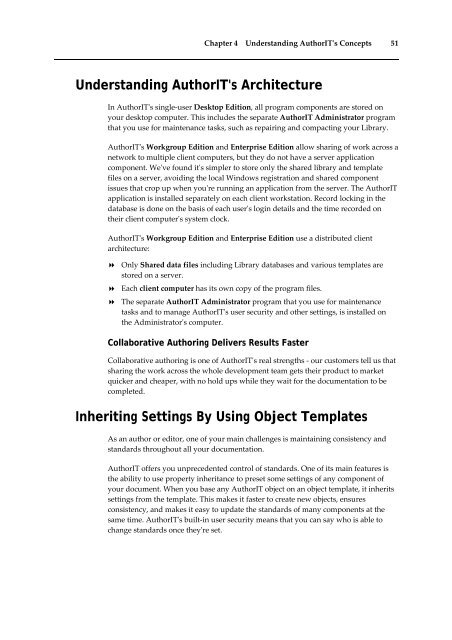Getting Started With AuthorIT - instructional media + magic
Getting Started With AuthorIT - instructional media + magic
Getting Started With AuthorIT - instructional media + magic
You also want an ePaper? Increase the reach of your titles
YUMPU automatically turns print PDFs into web optimized ePapers that Google loves.
Chapter 4 Understanding <strong>AuthorIT</strong>ʹs Concepts 51<br />
Understanding <strong>AuthorIT</strong>'s Architecture<br />
In <strong>AuthorIT</strong>ʹs single‐user Desktop Edition, all program components are stored on<br />
your desktop computer. This includes the separate <strong>AuthorIT</strong> Administrator program<br />
that you use for maintenance tasks, such as repairing and compacting your Library.<br />
<strong>AuthorIT</strong>ʹs Workgroup Edition and Enterprise Edition allow sharing of work across a<br />
network to multiple client computers, but they do not have a server application<br />
component. Weʹve found itʹs simpler to store only the shared library and template<br />
files on a server, avoiding the local Windows registration and shared component<br />
issues that crop up when youʹre running an application from the server. The <strong>AuthorIT</strong><br />
application is installed separately on each client workstation. Record locking in the<br />
database is done on the basis of each userʹs login details and the time recorded on<br />
their client computerʹs system clock.<br />
<strong>AuthorIT</strong>ʹs Workgroup Edition and Enterprise Edition use a distributed client<br />
architecture:<br />
Only Shared data files including Library databases and various templates are<br />
stored on a server.<br />
Each client computer has its own copy of the program files.<br />
The separate <strong>AuthorIT</strong> Administrator program that you use for maintenance<br />
tasks and to manage <strong>AuthorIT</strong>ʹs user security and other settings, is installed on<br />
the Administratorʹs computer.<br />
Collaborative Authoring Delivers Results Faster<br />
Collaborative authoring is one of <strong>AuthorIT</strong>ʹs real strengths ‐ our customers tell us that<br />
sharing the work across the whole development team gets their product to market<br />
quicker and cheaper, with no hold ups while they wait for the documentation to be<br />
completed.<br />
Inheriting Settings By Using Object Templates<br />
As an author or editor, one of your main challenges is maintaining consistency and<br />
standards throughout all your documentation.<br />
<strong>AuthorIT</strong> offers you unprecedented control of standards. One of its main features is<br />
the ability to use property inheritance to preset some settings of any component of<br />
your document. When you base any <strong>AuthorIT</strong> object on an object template, it inherits<br />
settings from the template. This makes it faster to create new objects, ensures<br />
consistency, and makes it easy to update the standards of many components at the<br />
same time. <strong>AuthorIT</strong>ʹs built‐in user security means that you can say who is able to<br />
change standards once theyʹre set.
















